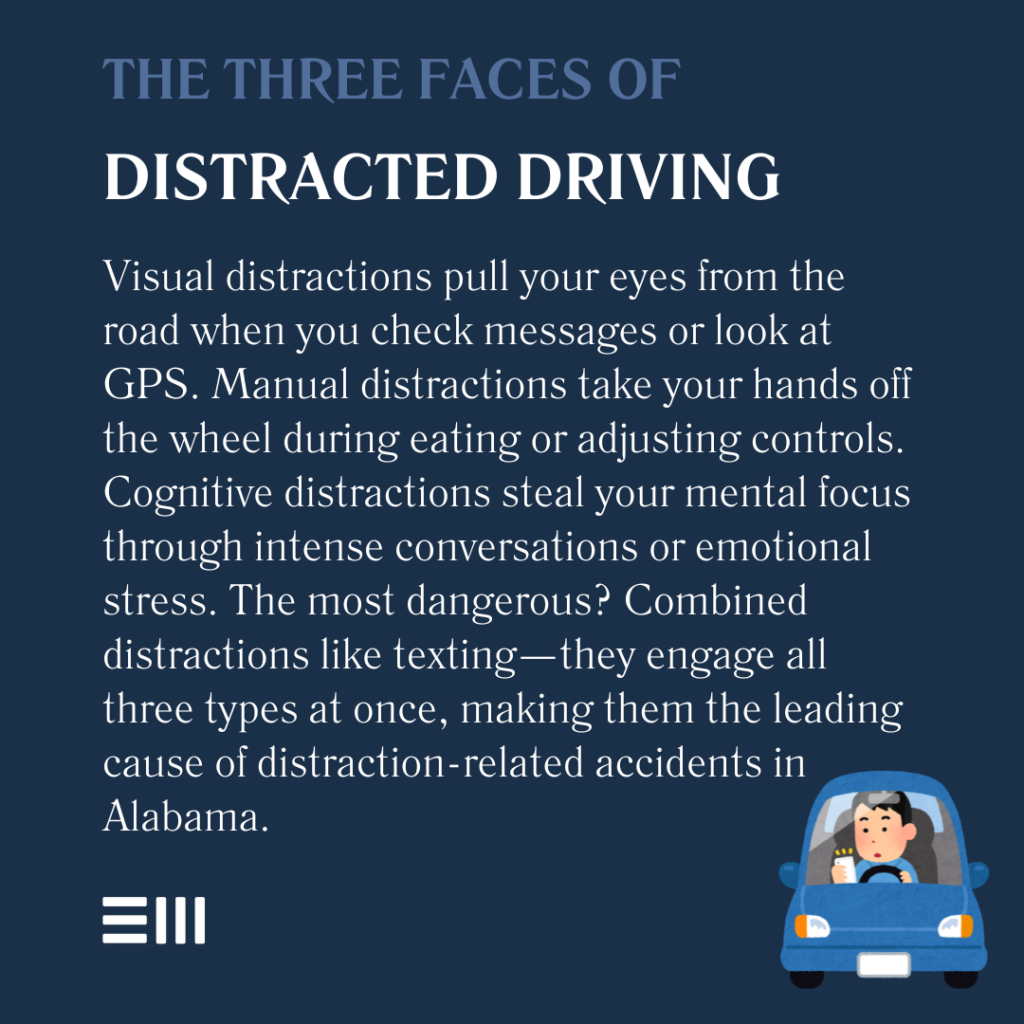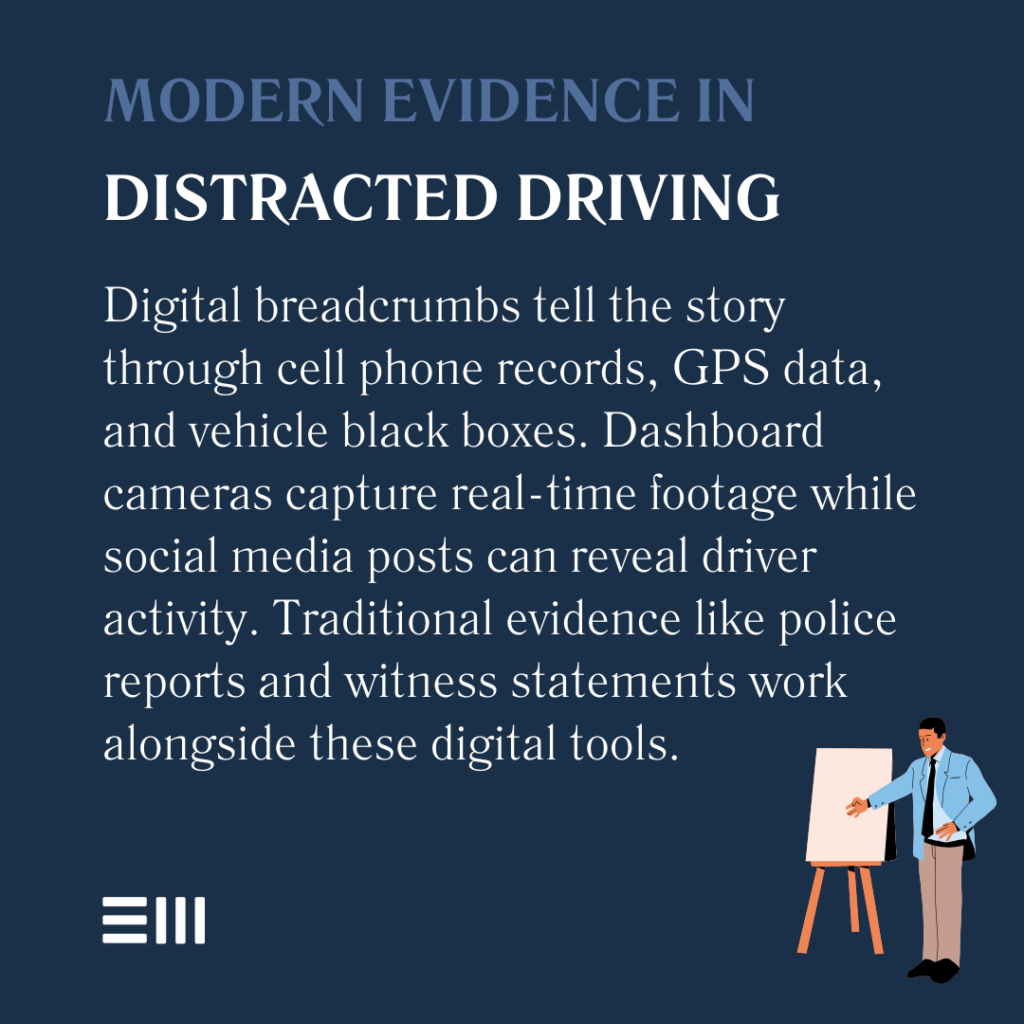
On a sunny morning along I-459, a father’s split-second decision to check his work email transformed an ordinary commute into a life-altering moment.
Three cars, eight lives, and countless ripple effects—all from a moment of distraction that seemed harmless at the time.
As our vehicles become extensions of our offices and social spaces, the line between staying connected and staying safe grows increasingly blurred.
The legal system has evolved to address this modern danger, creating a complex web of consequences and liability that every Alabama driver needs to understand.
Understanding Distracted Driving Laws in Alabama
Before diving into specific regulations, it’s important to note that Alabama recognizes three distinct types of distracted driving: visual, manual, and cognitive distractions.
Each type carries its own set of legal implications and potential consequences under Alabama Code Section 32-5A-350.
1. Visual Distractions (Eyes off Road)
- Reading texts or emails;
- Looking at GPS navigation;
- Watching videos;
- Checking social media;
- Looking at roadside activities;
- Personal grooming; and
- Managing children or pets.
2. Manual Distractions (Hands off Wheel)
- Texting while driving;
- Making phone calls;
- Using smartphone apps;
- Eating or drinking;
- Adjusting radio or climate controls;
- Reaching for items in the vehicle; and
- Handling pets or children.
3. Cognitive Distractions (Mind off Driving)
- Engaging in intense conversations;
- Daydreaming;
- Road rage incidents;
- Work-related stress; and
- Emotional distress.
These classifications help courts and law enforcement determine the severity of violations and appropriate penalties.

Legal Penalties and Consequences
In Alabama, distracted driving penalties vary based on the driver’s age and number of previous offenses. The state implements a tiered system of fines and consequences to address this growing concern.
For Drivers Under 18:
- Traffic violation with fines between $150-$350;
- 2 points added to driving record;
- Possible license suspension for repeat offenses;
- Required parent/guardian notification; and
- Mandatory court appearance in most jurisdictions.
For Drivers 18 and Older:
- First offense: $25 fine;
- Second offense: $50 fine;
- Third offense: $75 fine;
- Additional penalties possible if distraction leads to an accident; and
- Enhanced penalties if violation occurs in school zones or construction areas.
Additional Consequences for All Drivers:
- Increased insurance premiums;
- Possible license suspension for severe or repeat violations;
- Required defensive driving courses at court discretion;
- Enhanced penalties if distraction results in injury or death; and
- Civil liability for damages caused by distracted driving.
Understanding these penalties helps drivers make informed decisions and recognize the serious nature of distracted driving violations. The consequences extend beyond immediate fines to affect various aspects of a driver’s record and privileges.
Determining Liability in Distracted Driving Cases
Understanding liability in distracted driving cases involves examining multiple factors that courts and insurance companies consider when assessing responsibility.
Alabama’s contributory negligence law adds complexity to these determinations.
Primary Liability Factors:
Driver Actions and Conditions
- Duration of distraction
- Type of distracting activity
- Preventability of distraction
- Driver’s prior record
- Speed at time of incident
Environmental Factors
- Traffic conditions
- Weather conditions
- Road conditions
- Time of day
- Road maintenance issues
Other Parties
- Other drivers’ actions
- Pedestrian behavior
Vehicle Factors
- Vehicle mechanical conditions
Documentation Required
- Police reports
- Witness statements
- Expert testimony
- Medical records
- Vehicle damage reports
These elements work together to create a comprehensive picture of liability in each case. Alabama’s pure contributory negligence system means that if a plaintiff is found even 1% at fault, they may be barred from recovery.
Evidence Collection and Documentation
Proper documentation strengthens your position in legal proceedings and insurance claims. Modern technology has expanded the types of evidence available in distracted driving cases.
Essential Evidence Types:
Physical Evidence
- Skid marks;
- Vehicle damage;
- Property damage;
- Road conditions; and
- Weather conditions.
Law Enforcement Documentation
- Accident scene diagrams;
- Officer observations;
- Citation information;
- Witness statements; and
- Field sobriety tests if applicable.
Digital Evidence
- Cell phone records;
- GPS data;
- Social media posts;
- Dashboard camera footage;
- Traffic camera recordings; and
- Vehicle black box data.
Medical Documentation
- Emergency room records;
- Treatment plans;
- Specialist consultations;
- Rehabilitation records; and
- Mental health impacts.
Maintaining organized records of all documentation ensures stronger legal representation and more favorable outcomes. Recent Alabama court decisions have emphasized the importance of digital evidence in distracted driving cases.

Insurance Implications and Coverage
Distracted driving incidents can significantly impact insurance coverage and future rates. Understanding these implications helps protect your financial interests in both the short and long term.
Premium increases:
- Average 30% increase first offense;
- Possible policy cancellation; and
- Multi-year impact.
Coverage considerations:
- Liability limits review;
- Uninsured motorist coverage;
- Personal injury protection;
- Property damage coverage; and
- Medical payments coverage.
Long-term effects:
- Insurance score impact;
- Future insurability;
- Multi-policy implications;
- Employment consequences; and
- Commercial driving restrictions.
Working with both legal counsel and insurance providers helps navigate these complex matters effectively. Recent trends show insurance companies taking increasingly strict stances on distracted driving incidents.
Frequently Asked Questions About Distracted Driving Cases in Alabama
Many people share common concerns when facing distracted driving charges or dealing with accidents involving distracted drivers in Alabama.
Here are answers to the most pressing questions we often receive from our clients.
What Qualifies as Distracted Driving in Alabama?
Distracted driving encompasses any activity that diverts attention from safe vehicle operation, including texting, eating, or adjusting vehicle controls.
How Long Do I Have to File a Claim?
The statute of limitations for distracted driving accidents in Alabama is two years from the date of the incident.
Will My Insurance Rates Increase After a Distracted Driving Citation?
Most insurance companies increase rates following distracted driving citations, typically for three to five years.
Can I Fight a Distracted Driving Ticket?
Yes, with proper legal representation and evidence, you can contest distracted driving citations in court.
What if the Other Driver Denies Being Distracted?
Evidence such as cell phone records, witness statements, and traffic camera footage can help prove distraction.
Steps to Protect Your Rights
Taking immediate action after a distracted driving incident helps protect your legal rights and strengthen your case. Consider these essential steps:
- Document all aspects of the incident;
- Seek medical attention if needed;
- Report the incident to authorities;
- Contact insurance providers;
- Preserve evidence and records;
- Consider legal representation;
- Follow medical treatment plans; and
- Keep detailed expense records.
Following these steps creates a solid foundation for your legal case.
Get Expert Legal Support Today
Our experienced legal team understands the complexities of distracted driving cases and stands ready to protect your rights. We provide comprehensive legal support tailored to your specific situation.
Schedule your free consultation. We’ll evaluate your case and help you understand your options moving forward.
Can't find what you're looking for? Search our site below.










